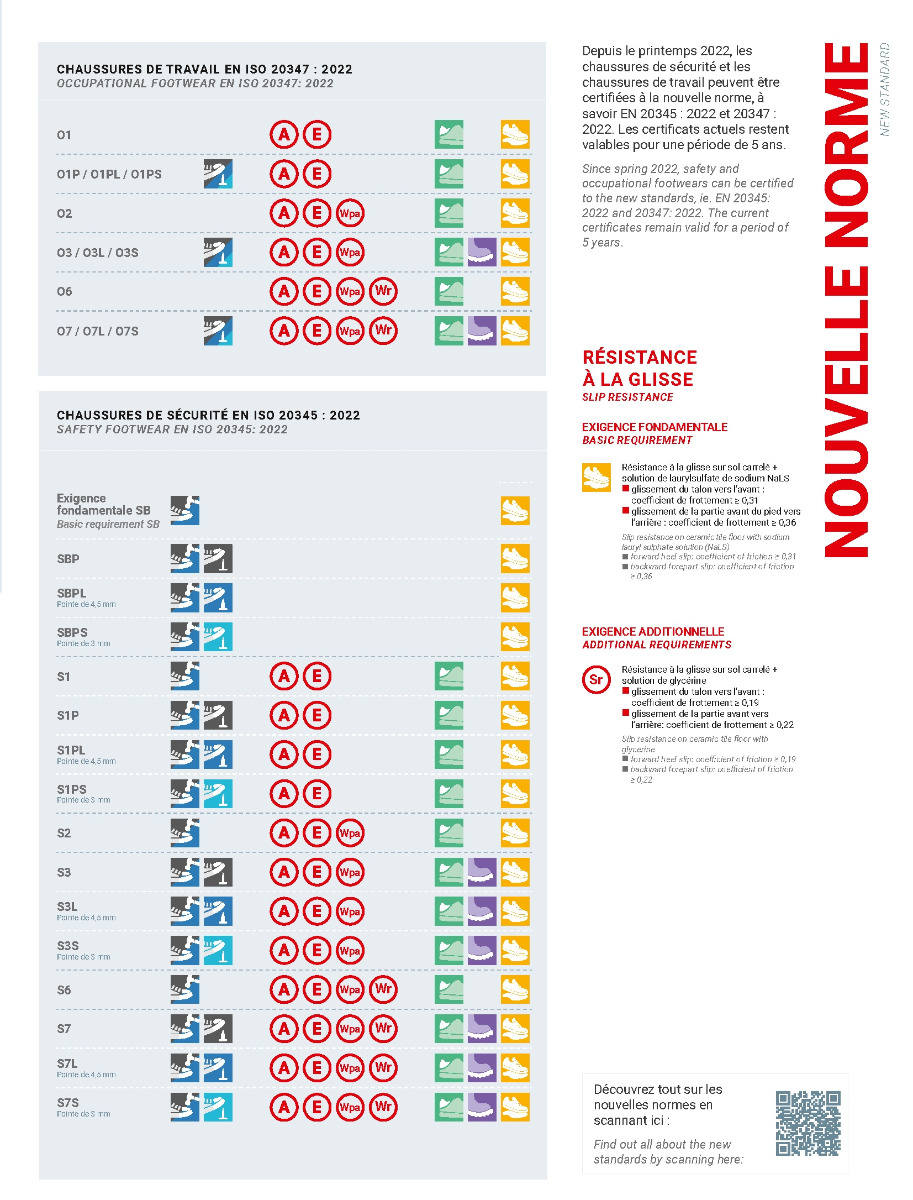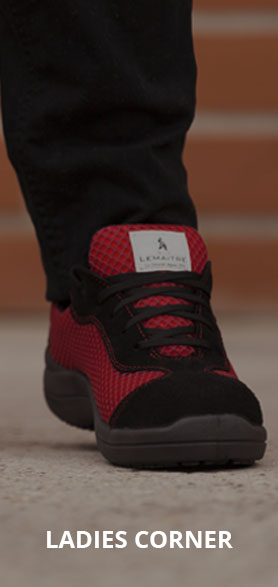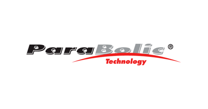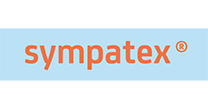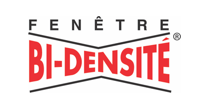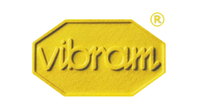All you need to know about the new EN ISO 20345 standard for safety footwear
Standards and markings for safety shoes : the comlete guide
Before delving into the complex world of safety shoe standards and markings, it is essential to clarify a fundamental distinction: that which exists between work shoes and safety shoes. This difference, though subtle, is crucial for understanding workplace protection.
The determining criteria is in the presence of a protective toe cap. A typical work shoe, used for its comfort and durability, does not have this feature. In contrast, a safety shoe is specifically designed with a protective toe cap to ensure foot safety, in accordance with the EN ISO 20345 standard.
Furthermore, the standards and markings associated with safety shoes go beyond a simple distinction between work and safety shoes. They go further by classifying safety shoes into different categories, each catering to specific levels of protection, suitable for various work environments and professional risks. For example, shoes compliant with the EN 20345 standard are identifiable by the "S" marking, greatly simplifying the understanding and selection of appropriate standards for each professional situation.
Now that this fundamental distinction is established, let's explore in more detail the various standards and markings that govern safety shoes.
Additional Requirements
To help you better understand the distinctions, here is a brief summary of the main markings you will encounter:
A: Antistatic shoes
E: Heel energy absorption capacity
Fo: Sole resistance to hydrocarbons
Wr: Water-resistant shoe
Wpa: Upper resistance to water penetration and absorption (formerly Wru)
AN: Additional protection for the ankle
M: Additional protection for the metatarsals
CI: Thermal insulation against cold
HI: Thermal insulation against continuous heat
HRO: Heat resistance of the sole up to 300°C
CR: Cut resistance
LG: Ladder grip system
SC: Scuff resistance for toe protection
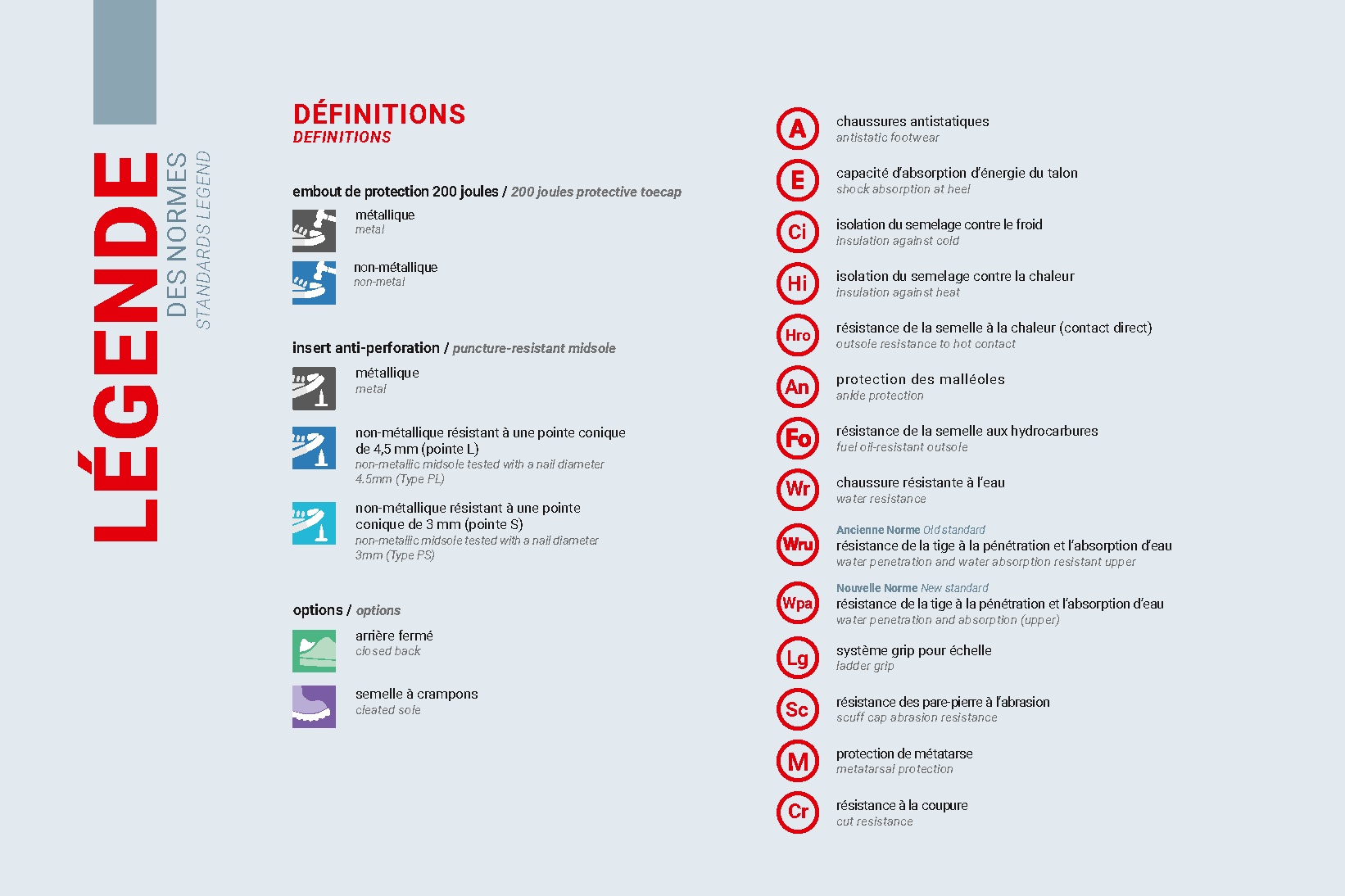
Now that we have demystified the technical jargon, let's dive into the heart of the matter: the different categories of safety shoes and what they imply in terms of protection and features.
SB: Basic standards
The basic safety shoe, marked "SB," is the basic model to meet European market requirements for workplace safety.
SB safety shoes are designed to withstand an impact of 200 joules. They also offer essential protection against slipping risks (with SRA, SRB, or SRC standards) and effective abrasion resistance, whether they have a closed back or not.
S1 et S1P: The basic safety shoe
The S1 marking S1 marking, applied to safety shoes, indicates a level of protection that goes beyond the basic requirements (SB). S1-marked shoes include antistatic properties (A), heel energy absorption (E), resistance to hydrocarbons (Fo), and a closed back design. These additional features make them suitable for specific work environments where these additional protections are essential.
When you see an S1P marking, as in the case of S1P models, it indicates that all the features of S1 are present, with the crucial addition of a puncture-resistant sole (P). These safety shoes are specially designed to provide complete protection in dry or indoor environments, making them ideal for professionals in trades such as craftsmanship, light industry, or logistics.
With the update of the EN ISO 20345 standard, new models such as S1PL or S1PS have emerged, offering specific features tailored to even more targeted needs, which we will discuss in more detail later in this article.
To summarize:
S1 = SB (basic requirements) + A (antistatic) + E (heel energy absorption) + Fo (sole resistance to hydrocarbons) + Closed heel
S1P = S1 + P (puncture-resistant sole)
S2: Water penetration resistant safety shoes
The S2 marking on safety shoes indicates an evolution in the range of protection offered. In addition to all the features found in S1 models, S2 shoes add an essential functionality: increased resistance of the upper to water penetration and absorption. This property is identified as Wru (Water Resistant Upper) according to the old standard and as Wpa (Water Penetration and Absorption) in the updated version of the standard.
This additional feature makes S2 shoes particularly suitable for professionals working in environments where exposure to moisture is frequent, such as in the restaurant or food processing industries.
To summarize:
S2 = S1 + Wru/Wpa (resistance of the upper to water penetration and absorption)
S3: Complete safety shoes
Safety shoes marked S3 are much more comprehensive. They combine the features of S2 models with crucial additional features: a puncture-resistant sole (P) and a treaded sole, ensuring enhanced grip and safety.
These shoes are specially designed to meet the requirements of outdoor activities and humid environments. They are therefore highly recommended for professionals in construction, landscaping, and various industrial sectors.
S2 = S1 + Wru/Wpa (resistance of the upper to water penetration and absorption)
S4 et S5: Safty shoes for specific conditions
Safety shoes are classified in two ways, Class I and Class II:
Class I shoes (leather and other materials) can be marked SB, S1, S2, S3, S6, S7, and Class II shoes (all polymer, rubber) can be marked S4 and S5.
S4 and S5 safety boots are essential for professions such as agriculture, construction, and other industries where working environments are particularly demanding.
Evolution of EN ISO 20345 Standard
End of Fo Requirement
With the introduction of the new EN ISO 20345 standard, the Fo marking, which denotes sole resistance to hydrocarbons, is no longer a mandatory requirement. While this feature was considered marginal, it is important to note that the majority of safety shoes will continue to meet this requirement as a standard feature. However, it will no longer be a mandatory criterion for achieving the S1, S2, and S3 classifications.
However, for professionals operating in environments where the presence of hydrocarbons is frequent, it is strongly recommended to opt for safety shoes with the additional Fo standard for optimal protection.****
To summarize: The Fo marking is no longer mandatory and becomes an additional standard.
Slip resistance
The slip resistance of a safety shoe is currently symbolized by three markings: SRA, SRB, and SRC.
SRA = tested on ceramic tile with detergent and water
SRB = tested on steel floor with glycerine (oil)
SRC = SRA + SRB
The new EN ISO 20345 standard brings significant changes to these markings. The SRA test remains a requirement but will no longer be specified individually. It will now be integrated into the basic requirements (SB), becoming a baseline standard for all safety shoes sold in the European market.
The most significant change concerns the SRB marking. The test, which was previously conducted on a steel floor with glycerine, will now be performed on a tiled floor, still with glycerine, to better represent real-world conditions. As a result, the SRB marking evolves into the new SR marking, becoming an additional requirement.
Furthermore, the slip resistance test methods also undergo a modification: the tests will no longer be conducted flat but will incorporate heel-to-toe and toe-to-heel movements, more closely mimicking natural movements during walking.
To summarize:
- Current markings for slip resistance (SRA, SRB, SRC) will be revised.
- The SRA test becomes a fundamental requirement (SB).
- The SRB test is replaced by the SR marking and becomes an additional standard.
- Slip resistance tests will no longer be conducted on the heel and flat of the sole. They will be carried out from heel to toe and from toe to heel.
The new EN 20345 standard explained in a video by Jean-Pierre Boutonnet, our Lemaitre expert.
Puncture resistance
In the current framework, puncture resistance, marked as an additional requirement (P), is essential for S1P and S3 classifications. However, until now, no specific distinction was made between metallic and non-metallic inserts in terms of resistance testing.
The new EN ISO 20345 standard brings a significant change in this area. For safety shoes with a metallic insert (P), the testing protocol remains unchanged, still using a standard 4.5 mm point. This ensures the continuity of the recognized protection provided by these metallic inserts.
However, significant changes concern shoes with non-metallic inserts. In this context, two new markings are introduced:
- PL (Large Point): This marking corresponds to a test with a large 4.5 mm point, similar to the one used for metallic insert tests. This marking indicates robust and versatile protection.
- PS (Small Point): This marking refers to a test with a finer 3 mm point and a force of 1100 newtons, providing specific protection in conditions where finer puncture risks are present.
With the introduction of this new standard, you will find safety shoes with indications such as S1PS, S1PL, S3S, and S3L, designating models with non-metallic inserts. Meanwhile, the S1P and S3 markings will continue to indicate safety shoes equipped with metallic puncture-resistant inserts.
To summarize:
There are now two categories of puncture-resistant inserts:
- Metallic (P): tests carried out with a 4.5 mm point.
- Non-metallic: PL for tests with a large 4.5 mm point and PS for small 3 mm points.
New EN 20345 standard: puncture explained in a video by Jean-Pierre Boutonnet.
New protection categories
Currently, shoes classified as S2 or S3 are marked as Wru, indicating that the upper of the shoe resists penetration and absorption of water. However, it is crucial to understand that this feature does not make the shoe completely "waterproof." The Wru marking applies only to the upper, not the entire shoe.
With the arrival of the new standard, the Wru marking evolves into Wpa. This update aims to provide further clarification on the nature of water resistance.
The Wr (Water Resistant) marking means that the safety shoe is designed with features such as sealed seams or a waterproof and breathable membrane, ensuring complete protection against water.
To provide users with a clearer identification of completely waterproof shoes, the new standard introduces two new markings, S6 and S7:
- S6 corresponds to a safety shoe with S2 characteristics, enhanced with the Wr property. This indicates a shoe without a puncture-resistant sole but is water-resistant.
- S7 builds on S3 characteristics, with the addition of the Wr property. This designates a safety shoe with a puncture-resistant sole and complete water resistance.
To summarize:
- Wru becomes Wpa.
- Do not confuse Wr (resistance to water penetration of the entire shoe) and Wpa (resistance to water penetration on the top of the shoe).
- New category S6 (S2 + Wr) and S7 (S3 + Wr).
New EN 20345 qtandard: new ctategories explained in a video by Jean-Pierre Boutonnet.
New additional requirements
The recent update to the EN 20345 standard introduced two new additional requirements, each aimed at improving the safety and functionality of safety shoes in specific contexts:
- LG "Ladder Grip": The LG criterion establishes precise standards for heel design. It must be sufficiently recessed, with a defined minimum height and adequate space between the heel and the front of the sole. Additionally, this specification requires the integration of cleats to ensure optimal grip on ladder rungs. This feature aims to reduce the risk of slips or falls when using ladders, a crucial element for safety in many professions.
- SC "Scuff Cap": The SC marking distinguishes between overcaps primarily designed for aesthetic reasons and those that offer genuine functionality. By enhancing abrasion resistance, SC overcaps not only provide better durability but also offer additional protection in work environments where shoes are regularly subjected to friction and impacts.
To summarize:
- New additional requirement LG "Ladder Grip" for workers who regularly use ladders.
- The SC "Scuff Cap" requirement to identify safety shoes with extended lifespan overcaps.
New EN 20345 standard: additional requirements explained in a video by Jean-Pierre Boutonnet.
Implementation of this new standard
For a safety shoe to be officially recognized and marked, it must undergo a series of rigorous tests conducted by a certified organization. At Lemaitre, we collaborate with the recognized certification body, CTC (Centre Technique du Cuir).
When our shoes pass these tests successfully, they receive Attestations of Type Examination (AET) in accordance with the EN 20345 standard, attesting to their compliance for a period of five years. For example, a safety shoe certified in December 2021 according to the old standard will remain valid until December 2026.
It is crucial to emphasize that safety shoes complying with the old standard should not be perceived as outdated or inferior. They will continue to coexist with models certified according to the new standard during a transition period, still offering a reliable and proven level of protection. If you have been wearing safety shoes compliant with the old standard for several years, rest assured of their reliability and durability.
Therefore, it should not be surprising to find identical models of safety shoes on the market, where a size 39 may be marked according to the new standard and a size 42 according to the old one. This temporary coexistence is a natural aspect of the transition to the complete update of safety standards in our industry.
New EN 20345: validity of AET explained in a video by Jean-Pierre Boutonnet.
Conclusion
These standards are not just a series of technical and complex rules. They represent essential partners in our common commitment to safer and more productive work environments. Each standard, each marking has been designed with a clear goal: to ensure that every professional benefits from the best possible protection, tailored to the specific requirements of their profession.
We understand that navigating through these standards can sometimes be confusing. That's why our dedicated team at Lemaitre Sécurité is always ready to provide you with personalized guidance.
